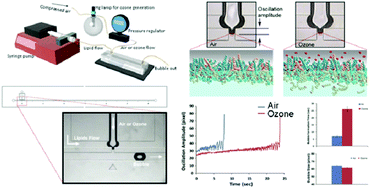A microfluidic-based bubble generation platform enables analysis of physical property change in phospholipidsurfactant layers by interfacial ozone reaction†
Abstract
The air-liquid interface filled with pulmonary

* Corresponding authors
a Nanosystems Biology Cancer Center, California Institute of Technology, MC 127-72, Pasadena, California 91125, USA
b Division of Chemistry and Chemical Engineering, California Institute of Technology, MC 127-72, Pasadena, California 91125, USA
c Molecular and Medical Pharmacology, University of California, Los Angeles, California 90095, USA
d
Department of Chemistry, Pohang University of Science and Technology (POSTECH), Pohang, Republic of Korea
E-mail:
hughkim@postech.edu
Fax: +82-54-279-3399
Tel: +82-054-279-2341
e Graduate School of EEWS, Korea Advanced Institute of Science and Technology, Daejeon, Republic of Korea
The air-liquid interface filled with pulmonary

 Please wait while we load your content...
Something went wrong. Try again?
Please wait while we load your content...
Something went wrong. Try again?
Y. S. Shin, T. S. Choi, H. Kim, J. L. Beauchamp, J. R. Heath and H. I. Kim, Lab Chip, 2012, 12, 5243 DOI: 10.1039/C2LC40940B
To request permission to reproduce material from this article, please go to the Copyright Clearance Center request page.
If you are an author contributing to an RSC publication, you do not need to request permission provided correct acknowledgement is given.
If you are the author of this article, you do not need to request permission to reproduce figures and diagrams provided correct acknowledgement is given. If you want to reproduce the whole article in a third-party publication (excluding your thesis/dissertation for which permission is not required) please go to the Copyright Clearance Center request page.
Read more about how to correctly acknowledge RSC content.
 Fetching data from CrossRef.
Fetching data from CrossRef.
This may take some time to load.
Loading related content
